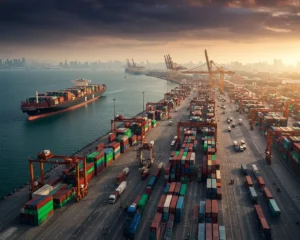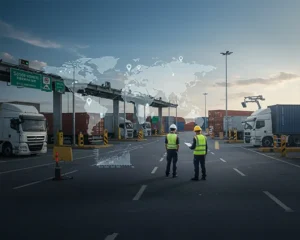Retail Logistics and E-Commerce Supply Chains
- ULS Freight

The rise of online shopping has changed the way goods move from warehouses to consumers. Traditional supply chains focused on bulk deliveries to physical stores, while retail logistics e-commerce networks are designed for smaller, faster, and more frequent shipments. This shift requires precise planning, technology integration, and constant communication across all levels of the B2C delivery supply chain.
In e-commerce logistics, success depends on how efficiently retailers can move products from distribution centers to the customer’s doorstep. Unlike conventional store logistics, online retail relies heavily on spatial organization of e-commerce logistics — strategically locating warehouses and transport hubs closer to key cities and borders.
As e-commerce changes retailer logistics networks, businesses must balance speed, cost, and customer expectations. Companies that adapt early with flexible systems gain a significant advantage in a market where delivery speed defines customer loyalty.
Current Trends Across Canada & the USA
e-commerce is now one of the most critical parts of logistics, as customers expect same-day or next-day service. Retailers are adopting mixed models that combine home delivery and click-and-collect to provide flexibility.
Parcel delivery services have also evolved with the rise of urban logistics depots, allowing packages to move quickly between carriers, hubs, and consumers. Retailers offering same-day and next-day delivery in e-commerce are investing in advanced routing tools and real-time tracking to meet rising expectations.
Successful businesses focus on strategies for last-mile parcel delivery in e-commerce, including electric delivery fleets, micro-warehouses in city centers, and data-driven delivery scheduling. These innovations are shaping the future of retail and e-commerce operations across both Canada and the USA.
E-Fulfilment Center Networks and Distribution Hubs for Online Retail
Modern retailers rely on strong e-fulfilment center networks to meet fast delivery demands. These centers handle order picking, packing, and shipping with advanced automation. Strategic distribution centers for e-retailers are often located near ports, highways, or population centers to reduce transit time.
Location plays a key role. Businesses consider the locational choice of e-retail distribution centers carefully, evaluating delivery routes, rent costs, and access to skilled labor. Automated sorting and robotics improve efficiency, helping manage larger volumes without increasing labor costs.
The best companies follow best practices for managing distribution centers in online retail — combining advanced tracking systems, smart storage solutions, and flexible fulfillment models. By aligning operations with market demand, they create faster and more reliable delivery pipelines.
Inventory Management and 3PL Solutions for E-Commerce Retailers
Efficient e-commerce inventory management ensures that products are available where and when customers need them. Poor inventory control can lead to stockouts, delays, and lost sales. To prevent this, many retailers are partnering with 3PL e-commerce logistics providers who handle warehousing, fulfillment, and transportation.
These third-party logistics for online stores solutions help online retailers scale quickly without the high cost of managing their own warehouses. By integrating technology for tracking and reporting, 3PL providers offer full visibility over inventory levels and order status.
Outsourcing to a professional logistics company allows e-commerce brands to focus on growth while experts manage the complex side of storage and distribution. Let’s look at how these partnerships strengthen fulfillment efficiency.
Optimizing Inventory Management for High-Throughput E-Fulfilment
High-volume online stores require smart systems for handling orders efficiently. E-commerce inventory management tools powered by automation help track sales trends, forecast demand, and reduce manual errors.
Through automated backend operations in fulfillment, retailers can process thousands of orders daily with greater speed and accuracy. Real-time data sharing between warehouses and online platforms ensures customers always see up-to-date stock levels.
By optimizing inventory management for high-throughput e-commerce fulfillment, businesses avoid delays and reduce costs — two essential factors in maintaining customer satisfaction in competitive markets.
How 3PL E-Commerce Logistics Supports Growing Online Stores
Partnering with a 3PL e-commerce logistics provider offers flexibility and scalability for expanding online stores. These experts handle inventory storage, packaging, shipping, and even returns. With established networks across Canada and the USA, they help businesses reach new markets efficiently.
Since they understand how e-commerce changes retailer logistics networks, 3PL providers design systems that integrate seamlessly with online sales platforms. They also support the B2C delivery supply chain, managing both domestic and cross-border freight.
For retailers, outsourcing logistics means fewer operational headaches and faster delivery times. It’s an ideal choice for businesses focused on sales and customer engagement.
The Role of Third-Party Logistics (3PL) in B2C Delivery Supply Chains
Third-party logistics for online stores are now the backbone of modern e-commerce. These providers connect warehouses, transport fleets, and delivery agents under one unified system.
Through their knowledge of the spatial organization of e-commerce logistics, they optimize route planning and warehouse placement to reduce travel time and shipping costs. This approach ensures customers receive products faster without increasing delivery expenses.
By understanding how e-retailers choose locations for fulfillment versus storefronts, 3PL experts help businesses maintain low operational costs while improving speed and reliability.
Reverse Logistics and Returns Management for Online Retail
Returns are a natural part of online shopping, and handling them efficiently can build customer trust. Reverse logistics for online retail ensures that returned goods are inspected, restocked, or disposed of quickly.
Some goods less suitable for e-commerce, such as groceries and pharmaceuticals, require extra attention due to safety and temperature control concerns. Managing these returns properly maintains product quality and compliance with regulations.
Understanding what types of goods are challenging for e-commerce logistics allows businesses to design better systems that minimize loss and maximize customer satisfaction.
Challenges and Future Directions in Retail & E-Commerce Logistics
E-commerce continues to grow rapidly, but it also brings new challenges. Urban congestion, driver shortages, and fluctuating fuel costs all affect delivery speed and cost. Businesses must adapt by rethinking retail logistics and e-commerce strategies.
Unlike conventional store logistics, online retail requires higher flexibility and smarter warehouse distribution. Certain goods less suitable for e-commerce, such as perishables, still need specialized handling that not every logistics provider can offer.
Looking ahead, companies that understand how e-commerce changes retailer logistics networks will remain competitive. They’ll invest in innovation, automation, and sustainable delivery methods that meet both environmental and customer expectations.
Building Smarter, Faster, and More Resilient E-Commerce Logistics Networks
To thrive in today’s market, retailers must develop agile systems that can adapt to sudden changes in demand or supply chain disruption. E-commerce logistics and 3PL e-commerce logistics providers are using technology to make this possible.
AI and data analytics improve route efficiency, while automated backend operations in fulfillment enhance accuracy and speed. Urban hubs and high-demand goods depots are now strategically placed near customers to support next-day delivery in retail e-commerce.
Through these innovations, the B2C delivery supply chain is becoming smarter and more resilient. Companies adopting modern strategies for last-mile parcel delivery in e-commerce gain a competitive edge in both cost control and customer satisfaction.
Final Thoughts
Retail and e-commerce logistics are about connecting businesses to customers faster, safer, and smarter. From last-mile delivery innovations to advanced 3PL e-commerce solutions, every improvement helps retailers enhance their performance across North America.
At ULS, we specialize in building scalable logistics systems that support online retailers, distributors, and cross-border businesses in Canada and the USA. Our data-driven, technology-supported solutions help companies manage fulfillment efficiently and meet growing customer demands.
If your business is ready to strengthen its logistics network, partner with ULS today and experience faster, more reliable, and cost-effective delivery from warehouse to doorstep.
FAQs
A standard flatbed can carry up to 48,000 pounds depending on axle configuration and trailer type.
Contact ULS for a tailored transport plan including permits, escorts, and specialized equipment.
Each state and province requires separate oversized load permits based on weight, width, and route.
Typical transit ranges from five to nine days depending on destination, route conditions, and customs clearance.
About ULS Freight
We are Road freight forwarder based in Canada, and offering our road freight services all across the USA, Canada, and Mexico for the last 10 years.
Recent Posts

The Global Supply Chain Crisis: How Logistics Companies Are Responding

Cross-Border Freight Challenges: Navigating Compliance in a Global Market

